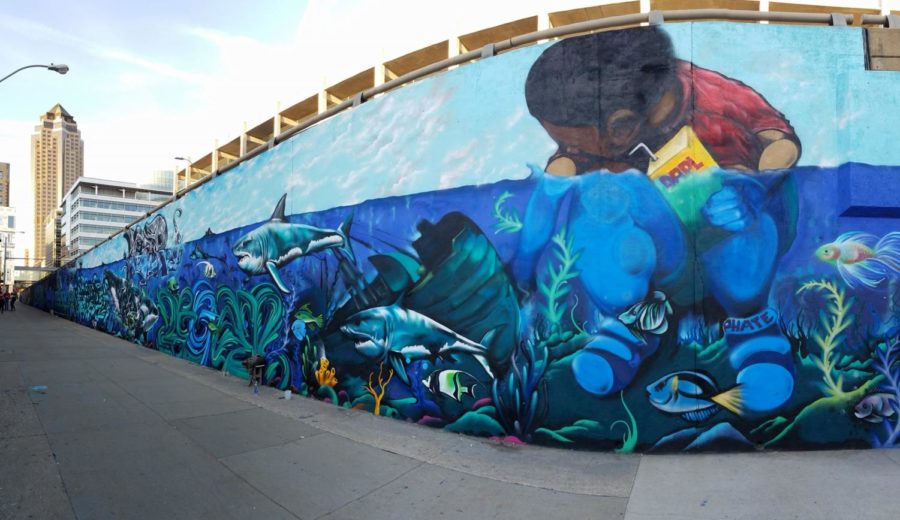The Complexity of Graffiti
May 16, 2018
It’s 2 a.m. at a railyard in Des Moines, Iowa.
The railroad cars sit parallel to each other, acting as single-file canvases on the tracks. It seems as if almost everyone in town is asleep, except for one person.
Among all these trains is a graffiti writer. He can hear every sound in the night. Earlier, he heard a police siren which made him look over his shoulder. The railyard provided nice cover for him, and once the siren became faint, he resumed spray-painting the side of the railroad car. Now a train enters the yard and rushes close to where he’s working. He ignores it because he’s focused on completing his work and escaping unnoticed.
This scene, as described by Asphate, a Des Moines graffiti writer, conveys what it can be like to practice illegal graffiti writing.
“You are creating something that you know the public is going to be able to see the next day [and] that feeling is addictive,” said Asphate.
Those who see his work the next morning might appreciate it as a piece of public art. Or they might view it as vandalism. Asphate doesn’t deny the reality that the definition of what he does is vandalism.
Graffiti falls under the classification of criminal mischief in the Iowa Code. According to Chapter 716.1 of the Code, “any damage, defacing, alteration, or destruction of property is criminal mischief when done intentionally by one who has no right to so act.” Getting caught creating unsanctioned graffiti can result in punishment of jail time, fines or probation, depending on the amount of damage done. These are risks graffiti writers take every time they produce illegal graffiti.
The motivations for creating graffiti might differ from person to person. There are those who do it with the purpose of damaging property, and then there are those who consider themselves artists. Their reasons for making graffiti can be as intricate as the mosaics they paint. Asphate believes that people would better appreciate graffiti as an artform if they understood the motivations behind graffiti writers.
“There is a lot of culture in graffiti art. A lot that the normal person will never see,” said Mode, another graffiti writer in Des Moines.
If graffiti culture is misunderstood, then it might be because graffiti writers practice their craft away from the public eye and often under the cover of darkness. Railyards and underneath bridges are common places to find graffiti.
“If you go under a bridge, there are seldom people or authority figures down there, so a graff writer may have four hours, five hours or may even have an entire night to paint and create a masterpiece. When you go under bridges, you’ll see the nice vivid, colorful things that make up murals that everybody, even the layman, will dig and won’t have any problems with and will consider art,” said Asphate.
Asphate said it’s harder to create more complicated forms of graffiti on street locations because these have higher concentrations of people, which doesn’t allow for a lot of time to work. That’s why it’s common to see tags, bubble letters and other graffiti forms that can be created at a much quicker rate. Asphate said people generally don’t like graffiti tags as much as intricate murals, and because they see tags more often, they tend to have a negative impression of graffiti. But he argued the importance of graffiti tags, saying they are the foundation for how writers learn to create the murals that people tend to enjoy more.
According to Asphate, to better appreciate graffiti tags, it’s important to understand why graffiti writers do them. He explained when graffiti writers tag their names on places like street corners and bridges, these acts represent a portrayal of their existence.
“How many people feel like they are lost at sea, like they are faded, like they don’t really matter, like they don’t really exist, and [among] all the voices and all the other people out here, that they are just one of a million specks? Graff writers get to sort of transcend that because they are going and they are making someone see that they existed,” said Asphate. “They existed when they can’t achieve that same existence anywhere else.”
“It becomes a very addictive thing and a very important thing for writers to put their names up in as many places as they can to exist as much as possible. Some of those will get erased, but if they put enough up, [the authorities] can’t erase them entirely, and even after they die, that name may still live,” said Asphate.
Asphate said if people can understand this concept, then they can better appreciate why graffiti tags are so important to the writers. There will always be those who view tags as a problem for property owners, but according to Asphate and Mode, serious graffiti writers don’t paint graffiti just anywhere. There are unwritten rules in graffiti culture about where it is acceptable to put graffiti. These rules have been passed down through the history of graffiti writing.
“Most people think writers go and do anything they want where they want, but that’s not the case,” said Mode.
According to Asphate, painting graffiti on places of worship, schools, houses, garages and local small businesses goes against the codes of graffiti culture. In addition to these places, Mode also added that personal vehicles and community centers are off limits.
“There is no sympathy or remorse [from graffiti writers] at all when large-scale corporate spots get hit [with graffiti],” Asphate said. “When it becomes a problem and when you are starting to cross lines and break the code is when you vandalize the ma and pa business that is struggling to just get by and everyone in the neighborhood knows them. That’s when trouble can come your way.”
Asphate said some of these rules stem from a working-class mentality that has always been prevalent in graffiti culture as well as a way to subvert the system.
“We look at public property as our property. If we are going to be driving out and about on a road and we happen to look up and see a billboard that has a McDonald’s [advertisement] on it or a billboard of any other corporate leach, then in our minds, we get to put our [graffiti] anywhere we want,” said Asphate.
Though many graffiti writers have this rebel mentality, it wasn’t what first inspired Asphate to learn graffiti. He was initially drawn to it because of his connection to hip hop culture and his fascination with graffiti as an artform. “Graffiti writers have a love and appreciation for letter form. We are rooted in the understanding of letter anatomy,” Asphate said. “We study scribes. We study different scripts. We study different fonts. We create our own fonts. When you see those nice colorful pieces that are hard for people to read, that is because those [graffiti writers] are creating their own alphabet.”
For people who are not deeply rooted in the culture, it can be hard to differentiate graffiti writing from gang graffiti, street art and regular vandalism.
“Graffiti art and vandalism are two completely different cultures,” said Mode. “But the sad truth is we get lumped into the same bracket.”
Mode explained that graffiti done by a real writer has different meanings behind it than gang graffiti or graffiti solely meant to damage properties. Though an artist like Mode finds different meanings between various types of graffiti, the law does not differentiate.
“Technically it’s all vandalism because it’s not your property,” said Cmdr. Geoff Huff of the Ames Police. “The problem is when it’s not your property you’re doing it on, you don’t have a right to do that. It’s costing someone. If you are interested in doing that kind of artwork, then … you have to work it through proper means or it’s all vandalism.”
Huff said he doesn’t fully discount the argument that graffiti can be viewed as an artform because he has seen graffiti he’s enjoyed. But he said even if it’s artistic in nature, it’s a problem because it costs time and money to clean up. In Ames, graffiti found in the parks is removed by the Parks and Recreation Department. Graffiti found on public roadways and sidewalks is handled by the Public Works Department.
Brad Becker of Ames Public Works shares similar sentiments toward graffiti as Huff. He also recalled some instances in Ames where he saw illegal graffiti he thought looked neat, but it still had to be cleaned up. Becker said he would support a dedicated area for legal graffiti if it ever became a viable option.
According to Becker, the biggest issue with graffiti is the time it takes to remove. “It does take a lot of staff time to go out and clean up graffiti when we have tons of other things to be doing,” said Becker.
Becker said that graffiti found on roadways can often take a few hours to power wash, and between the cost of materials and labor, it can total $200 to $300 to clean up. There are times when they have found graffiti on stop signs, and if they must replace the sign, it can cost around $100.
“It’s taxpayer money, and I think that’s the thing that a lot of people don’t recognize. You just destroyed your own property because you’re paying taxes. [Public properties are] funded through taxpayer dollars,” Huff said. “I don’t think a lot of people think in those terms, but every time that kind of thing is damaged, it is coming out of your pocket.”
When business owners and other private property owners are hit with graffiti, it’s their own responsibility to pay the costs to clean it up. Huff recalled a time around five years ago when a lot of buildings in Ames Campustown were getting tagged with graffiti. At the time, the police recommended to those building owners that they clean the graffiti as quickly as possible. “It’s like a magnet. It just collects [more graffiti]. It’s like the broken windows theory. If you focus on the small things, sometimes the big things don’t happen. Just taking down that little bit of graffiti now in a hurry might result in not getting something else, even a broken window later,” said Huff.
The broken windows theory, introduced by James Wilson and George Kelling in 1982, argues that visible signs of crime encourage further crime and disorder in that same area. That’s why police recommended that property owners clean up graffiti as quickly as possible when it occurs.
Asphate agreed with Huff’s point that the cost to clean up graffiti can hurt taxpayers. But he holds a different position about it. Asphate argued that funds do not need to be spent to clean up graffiti.
“Anytime money gets spent, there is a conscious decision and a very deliberate decision of where and how that money gets spent. No doubt it is true that if taxpaying dollars get spent to clean up defaced surfaces, that money is going there and can’t be allocated elsewhere. But who said it had to go there? Go address something else instead. Go address something else that is more important, something that’s more urgent,” Asphate said.
Furthermore, he referenced cities in Europe he’s visited such as Paris, Rome and Amsterdam. He said these cities have a lot of graffiti, but its presence doesn’t deter tourists from continually visiting these places. “[Graffiti] doesn’t change the culture or content of the city. They can say what they want to about having to clean up this or that, but I feel like you can put your money elsewhere,” said Asphate.
Asphate said that because of this mindset toward graffiti, the city of Des Moines is constantly fighting an uphill battle while needlessly spending money to clean it up. He compared cleaning graffiti to maintaining a lawn.
“It’s like cutting your lawn. Me personally, I hate yard work. To me, it’s super pointless because you cannot defeat the grass. Every time you cut the grass, it’s coming back. It’s going to come back and you’re going to have to get back out there again. So do you now start to spend your time elsewhere and maybe cut the grass every three weeks and do something else with your time? Or are you that person who is religiously out there every week, twice a week, cutting the grass just for the sake of doing so? To me, there is no value in that,” said Asphate.
He agreed there is some merit to the broken windows theory because it can be exemplified by certain spots in Des Moines that attract more graffiti than others. One such spot was the floodwall next to Central Campus beneath the Martin Luther King Jr. Parkway bridge along the Raccoon River. According to Asphate, this wall used to get hit by a lot of graffiti and consistently needed to be cleaned up by the city. However, this wall has since been designated by the city for Des Moines Public School students to paint a 200-foot-long graffiti mural. “Now that this is a sanctioned wall that people are legitimately authorized to paint on, there is no longer any need to clean up the wall due to a complaint. As a result, that tax money can be used elsewhere,” said Asphate.
Asphate believes this should set an example for other spots in Des Moines to be authorized for graffiti. He said there has been a history of red tape and bureaucracy which has made it hard to obtain authorization for legal graffiti projects. The authorization of the floodwall for graffiti could signify that the city is becoming friendlier toward these types of projects.
Mode said he has seen signs that people in the city are appreciating graffiti more. “[After] having done this for over 15 years, I can see a lot of change,” Mode said. “More and more people are allowing us to put murals up.”
Mode has painted at festivals such as Des Moines’ 515 Alive Music Festival and over the years has received more opportunities to be paid for his work. Asphate has done professional graffiti for the Iowa Speedway, among others. Asphate also said that more people are becoming tolerant of graffiti. “Right now, in Des Moines there is more permission for murals and more people looking for murals and artwork than ever before,” said Asphate.
In August, Asphate will present the third edition of his graffiti festival Color Codes. It will take place August 24 and 25 at the Des Moines Social Club and feature graffiti writers from Iowa and around the United States. He said the festival, which includes live painting, vinyl DJs and b-boy battles, will help to teach others what graffiti is all about. “I think [for] people with different backgrounds or different opinions, sometimes dialogue is all it takes to open the door,” said Asphate.







